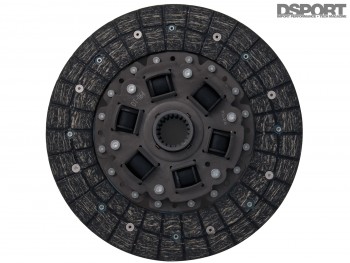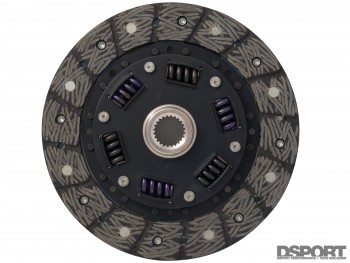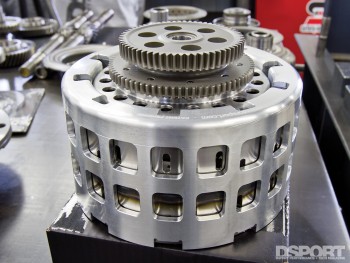Rubbing the Right Way
Coefficient of friction (COF) is a physics terms that describes the relative “stickiness” between two surfaces. A lower COF means that it’s easier for one surface to slip across another while a high COF means that it’s harder. The COF of the clutch disc material will influence the torque capacity of the system. The materials used generally fall into one of three categories: organic, metallic and exotic.
 OEM clutches are normally constructed of organic materials due to their user-friendly nature. They generally offer smooth engagement, extended life and minimal noise. High-performance organic discs usually feature a metal-backing behind the friction material and embedded copper to aid in transferring heat away from the disc, increasing reliability. While organic materials offer the smoothest engagement, repeated slipping of an organic disc can result in glazing of the disc. A glazed disc surface has a reduced coefficient of friction, which translates into a loss of power-holding capability.
OEM clutches are normally constructed of organic materials due to their user-friendly nature. They generally offer smooth engagement, extended life and minimal noise. High-performance organic discs usually feature a metal-backing behind the friction material and embedded copper to aid in transferring heat away from the disc, increasing reliability. While organic materials offer the smoothest engagement, repeated slipping of an organic disc can result in glazing of the disc. A glazed disc surface has a reduced coefficient of friction, which translates into a loss of power-holding capability.
Metallic disc materials provide some improved performance characteristics over organic discs. Metallic materials used conduct heat away from the disc, increasing durability and service life and reducing the chance of glazing the disc material. Some lightweight metallic discs may provide the additional benefit of reduced rotating mass. This allows the engine to “rev-up” faster as the engine has less rotating mass to accelerate. It also allows a faster “rev-down”, facilitating easier shiftability in fast-shift situations.
Carbon and Kevlar composites are two of the more exotic materials used in disc manufacturing. Carbon clutch discs exhibit a tendency to become stickier the harder they are pushed; this allows them to have relatively smooth engagement qualities under normal driving conditions while retaining the ability to hold increased torque capacity under aggressive driving. Kevlar’s elastic and tensile strength characteristics provide greater potential longevity than other materials. Like carbon, Kevlar is also very light which allows both materials to have greater physical dimension while retaining a relatively low inertial mass. However, Kevlar does suffer from a propensity to glazing, and like other exotic materials, its cost can drive up the price of the clutch system dramatically.
An Army of Two, Three or Four
Increasing the torque capacity of a single-disc clutch is not as effective as increasing the torque capacity by increasing the number of clutch discs in the system. Dual, triple and even quadruple disc clutch systems offer superior torque capacities over their single- disc cousins.
Multiplate systems consist of multiple discs separated by plates that offer a greatly- increased friction surface area spread across the multiple discs. These additional discs essentially multiply the torque capacity of the entire system. The use of additional discs also allows a reduction in the size and weight of the entire flywheel, clutch and pressure plate assembly. With the reduced clutch diameter comes the benefit of a reduced moment-of-inertia, providing faster engine acceleration and deceleration.
The tradeoffs for the vast increase in torque capacity from multi-plate clutch systems include several factors. Some multi-plate clutch systems may rattle loudly when disengaged. Additionally, the engagement of some multi-plate clutch systems may be difficult to modulate on street-driven applications. Even when these issues are not a concern, the price may be two to five times the price of a single clutch system.
DCT Clutches
The growing popularity of dual clutch transmissions (DCT) in both European and Japanese platforms has prompted attention from the aftermarket. As with most new technologies, DCTs were not engineered for tremendous or exceptional amounts of torque above what came standard with the given platform. This proved the weak link when the Nissan GT-R and Mitsubishi EVO X MR were first presented to the US market in 2008. As tuners began making more power, the limitations of the transmission and clutch capacities became apparent. In the case of the GT-R, the clutches started slipping at higher torque levels to protect the driveline from damage. The line pressure could be fooled into holding more torque, but that was simply a bandage.
Companies like Dodson Motorsports worked with clutch friction specialists (and stock DCT clutch manufacturer) Exedy Clutch to improve the torque holding capacity of the GT-R’s GR6 transmission. Soon after, DCT clutch upgrades capable of supporting well in excess of 1,200 horsepower became available. Development then expanded to include clutch upgrades for the EVO X MR.







